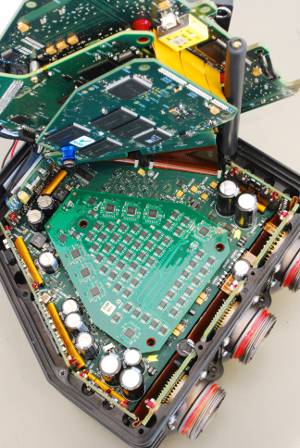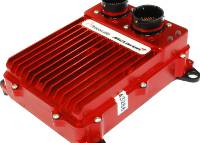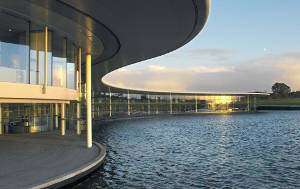
What you probably know about McLaren is that it makes Formula 1 cars.What you might not know,is that it designs and makes embedded processor systems.
Every car in Formula 1,every US Indy car,and every US NASCAR,has an engine control unit(ECU)that was made in Surrey by McLaren-and there are trains and planes carrying McLaren electronics too.
"In 2006,the FIA decided to go for a single set of electronics for everyone,"said Peter van Manen,managing director of McLaren Electronic Systems."What we had already meant we were in a position to win the contract for all of the cars in Formula 1."
Which it did.
The resulting ECU raced from the start of the 2008 season and will remain the standard F1 ECU until it is replaced in 2014,with a new ECU for
which McLaren has also won the contract.

McLaren's Formula 1 ECU:three Freescale processors in a seven board stack-with boards up to 32 layers
"Ninety-five per cent of a Formula 1 car changes every year.The electronics is part of the 5%of the car that doesn't,"said van Manen.

The firm has been supplying ECUs to IndyCar since 2007,and to NASCAR(red photo)since the beginning of this year,when the saloon car formula finally dropped carburettors in favour of fuel injection.
All of McLaren's ECU's sport main processors from Freescale,the result of a link that started in the days when Freescale was still called Motorola,and McLaren Electronic Systems was TAG Electronic Systems.
TAG chose 32bit PowerPC microcontrollers for the line of ECUs that it introduced at the start of 2000-following a move within TAG to auto-generate application software using model-based design tools.
"We have been putting electronics on cars since 1993,"said van Manen."At the start of the 2000 season,to make developing application software quicker,we moved to a different way of creating software.We wanted to use model-based software design based on graphical blocks,and to press a button to generate the code.
"Migrating software was straightforward,although the application code got much larger.We needed a powerful processor,and we decided to go with a Motorola 32bit,"van Manen added.
The graphical development tool is Matlab Simulink."We had to develop quite a lot of our own software tools to integrate it,"he said.
Although Freescale is a supplier of automotive processors,the CPU in the current F1 ECU is thought to be one of the firm's network processors,interfacing with the rest of the car through a pair of automotive processors-probably MPC565s.
Van Manen will not reveal which chip will be chosen for the central processor in the next-generation 2014 F1 ECU,saying only that"it will have more processing power,particularly for fine management of torque and management of the power train.With more processing we can have more sophisticated algorithms that can tease-out that last bit of performance".
This new ECU will almost certainly include FPGAs,Electronics Weekly was told.
Road car production beside McLaren's circular Technology Centre
The current ECU,as well McLaren F1 cars and its MP4-12C road car,are built at McLaren's headquarters which is hidden behind low hills near Woking in Surrey,and looks every bit the futuristic building you would expect.
McLaren's electronics facility includes pick-and-place,reflow,automatic optical inspection,and a surprising amount of hand assembly.
Hand assembly?
The F1 ECU is small and packed full-with a stack of seven PCBs(of up to 32 layers)in the middle,closely-surrounded by power components attached to the inner edge of the metal case.NASCAR racers have lower-revving engines,need less processing power,and have two-board ECUs.
"There are 24 hours of assembly in a Formula 1 ECU,"said van Manen,"with lots of manual assembly to pack the electronics into a small space."
The need for manual assembly does not stop there-McLaren also makes NASCAR alternators.
"They are all hand-wound to get the maximum amount of copper in.This is the most appropriate way building them,"said van Manen."If they were wound by machine,they would have to be 1-2kg heavier."
Once the ECUs are made,they are tested,vibrated,and thermally cycled to increase reliability.
"Electronics in racing cars are exposed to heat,vibration,shocks and electrical noise:in F1 for 100 minutes a race,and in NASCAR for three to four hours,"said van Manen,who went on to claim:"We have not had an electronics box stop a car;and we have had telemetry units running for nine years,and have had electronics running in Japan for a similar time."
With its design for high-reliability and use of environmental testing there are similarities between motorsport electronics and avionics.
"We have also developed an FAA-approved aircraft controller,"said van Manen."The requirement's very similar,although the testing is different."
Telemetry is the other big use for electronics in a Formula 1 car."Electronics on F1 cars either control or are for telemetry.Not much else is allowed,"said van Manen."There are 120-130 sensors on a Formula 1 car.A quarter of them are for control,rest are to see what the car is doing:measuring positions,temperatures,and movements."
These sensors are made in-house alongside the ECUs and are sold to other motorsport concerns,as well as being used in the firm's own cars.
Around 1.5Gbyte of data is gathered from sensors per car during a Formula 1 race.This is logged on the vehicle and transmitted back to the team's track-side headquarters by microwave telemetry.
"Telemetry is coded OFDM in L-band between 1.45GHz and 1.65GHz,"said van Manen."We have had the existing system since 1999."
L-band is near line-of-sight,with direct connection augmented by some reflection from large objects like grandstands.

The lake looks nice,and cools underground wind tunnels
Originally a single receiver was used."On long courses with trees,for example Monza,data was back-filled when a connection to the car was available.Now we have multiple antennas around the track with data back-hauled over the fibre installed for TV,"said van Manen.Managing reception is difficult.
"The car is moving very quickly,so hand-over between antennas and multi-path is not trivial."
Error handling is used to increase reliability,but there is no encryption to prevent other teams from spying.Instead security comes from not revealing the way data is packed into the available bandwidth.
And this bandwidth is under pressure."We started using this band in 1993.It was a military band,and is very convenient because it is better than line-of-sight,but we are already under pressure from mobile phones and TV for bandwidth.
So the search is on for somewhere else to go."Now we have multiple antennas for line-of-sight,we will almost certainly be moving up-frequency,"said van Manen.
Engine control and telemetry are not quite the only places electronics can be found on an F1 car.While almost all electronic control of aerodynamics is now banned,regenerative braking is very much encouraged by the FIA,which calls it kinetic energy recovery system(KERS).
Not all teams choose to use KERS,which is limited to 60kW(80hp)of assistance,further limited to 400kJ per lap.
McLaren does use it,where it takes the form of a motor/generator plus a lithium ion battery-delivering a useful acceleration boost,said van Manen.
In 2014,rule changes will mean existing 2.4 litre V8 engines will be replaced with 1.6 litre V6 engines,with up to 120kW of electric assistance available from KERS,limited to 4MJ per lap."This will be quite a large electric motor in parallel hybrid,"said van Manen.
From 2014,exhaust gas energy recovery will also be allowed.While this could mean a return to standard turbo-charging,it could also mean the introduction of a turbine/generator in the exhaust system,and a motor/compressor in the inlet tract-particularly as there will already be a high-capacity battery on the car for KERS.
This'hybrid turbocharger technology'[HTT]can be lag-free,and is already being promoted in the UK by Birmingham-based Aeristech and Essex motor start-up Controlled Power Technologies-which claims over 4kW can be extracted from an exhaust.





